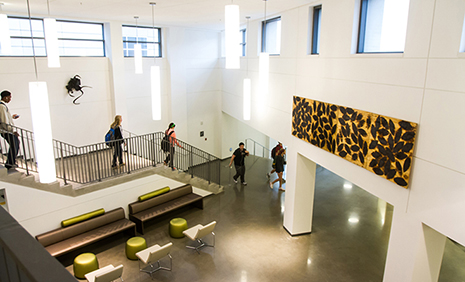
FAYETTEVILLE, Ark. – Hillside Auditorium, the newest academic building on the University of Arkansas campus, was officially dedicated in a ceremony in the second-floor lobby of the three-story structure on Wednesday, March 27.
The $14.6 million building is more than 35,000 square feet and contains a 487-seat auditorium and a smaller 290-seat auditorium, and both have been used for large lecture classes since the start of the spring semester. Construction began in late 2011 and was funded with bonds that are supported by the student facility fee.
Hillside Auditorium replaces the Science Engineering Auditorium, which had a capacity of 372 seats, and the former Geology Building. Neither building met the university’s academic needs or its current energy efficiency standards.
“Hillside Auditorium epitomizes our efforts to expand, refurbish and modernize our campus to meet the needs of our growing student population and of our state,” said Chancellor G. David Gearhart. “We have more than doubled our lecture hall capacity and replaced two buildings that were no longer functional with contemporary technology, teaching and learning. Beyond that we now have a building that was designed for sustainability – from its heating and air conditioning system to its LED lighting to, perhaps most impressively, its three tiers of living, green roofs.”
The building’s function, first and foremost, is as a much needed classroom.
 “Hillside Auditorium is a beautiful and vital addition to our campus, and I don’t think anyone realizes that more than our students,” said Provost Sharon Gaber. “We have been pressed for space the last two years. I think our students and faculty have been pleased to find that this is a significant upgrade from the former lecture hall and a vast improvement on Barnhill Arena and the Arkansas Union ballroom, which have provided emergency classroom space during construction. Our students and faculty have been remarkably patient and understanding, but I think they agree that Hillside Auditorium has been worth the wait.”
“Hillside Auditorium is a beautiful and vital addition to our campus, and I don’t think anyone realizes that more than our students,” said Provost Sharon Gaber. “We have been pressed for space the last two years. I think our students and faculty have been pleased to find that this is a significant upgrade from the former lecture hall and a vast improvement on Barnhill Arena and the Arkansas Union ballroom, which have provided emergency classroom space during construction. Our students and faculty have been remarkably patient and understanding, but I think they agree that Hillside Auditorium has been worth the wait.”
As its name suggests, the multi-level structure is built into the hillside that slopes down toward Dickson Street, just east of the Chi Omega Greek Theatre. It was designed so it would not obstruct the view of the campus and downtown Fayetteville from the theatre area. The upper roof features an elliptical terrace, which serves as an outdoor extension of the pavilion and is landscaped with Zelkova, Fringe, and Bosc Elm trees, as well as sweetspire and other ornamental plants. The middle and lower roofs are primarily sedums with some grasses and Russian sage. The green roofs reduce energy use by acting as a natural insulator, and the soil and plants filter and clean stormwater and reduce runoff. Planted roofs also reduce air pollution and greenhouse gas emissions, in keeping with campus sustainability initiatives.
Another dimension of the building is as a new showcase for public art. The university’s Public Art Oversight Advisory Committee is dedicated to the mission of bringing works of art to the campus and the community, and committee members realized that the Hillside Auditorium is an excellent location to exhibit public art.
As a result, four works by three internationally known artists are now on display inside Hillside Auditorium. Committee member Cynthia Nourse Thompson, a clinical assistant professor of art and curator of the U of A Fine Arts Center Gallery, found the sculpture, On File, by Chakaia Booker and the committee agreed to purchase the piece. Thompson also arranged for the other three works to be loaned to the university free of charge. Those works — The Difference Between Black and White and Infestation, by Willie Cole, and Number 23S, by Leonardo Drew — will be on display until May 2014. The costs of the purchase and installations were all covered by private funds dedicated to supporting the committee’s mission to bring art to the campus.
Leonardo Drew spoke during the dedication ceremony, describing his pleasure at seeing his work displayed where so many students will see it.
Thompson considers the display of these works of art as an extension of the Fine Arts Center Gallery, where earlier this year she curated an exhibit of work by contemporary African American artists. She titled the Hillside Auditorium installation “Sustenance: Contemporary Artists Reuse, Repurpose and Recreate.” This theme, she says, fits perfectly with the emphasis on sustainability in the design of Hillside Auditorium and additionally emphasizes the accessibility and relevance of artistic experimentation.
“This series demonstrates the U of A’s commitment to increase diversity and promote sustainability, as the artists in this installation are artists of color and work with materials considered sustainable or recyclable,” Thompson said. “These works investigate the intermarriage of art, material and context, by recontextualizing discarded materials – a rubber tire, old shoes, plywood, even pieces of wood and tree roots – in a compelling, unexpected manner.”
The architects for Hillside Auditorium were Perry Dean Rogers | Partners Architects, design architect, with Allison Architects, architect of record. Development Consultants, Inc. was the civil engineer and landscape architect. Olin Studio was involved early in the process and contributed to the design of the green roof. The general contractor was James H. Cone Inc.
Topics
Contacts
Mike Johnson, associate vice chancellor
Facilities
479-575-6601, mrj03@uark.edu
Steve Voorhies, manager of media relations
University Relations
479-575-3583,
voorhies@uark.edu